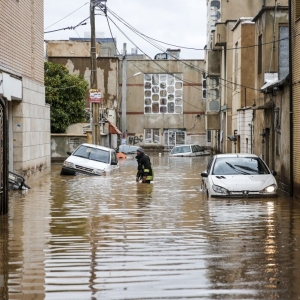Federal Water Tap, May 6: Trump, Democrats Float $2 Trillion Infrastructure Idea
The Rundown
More infrastructure talk from the White House and Congress. The Justice Department settles with ExxonMobil over a 2011 oil spill into the Yellowstone River. Representatives introduce a slew of water bills in Congress. Hydropower generation declined in 2018 due to lower snowpack in the West. Colorado River hydrologists will discuss the 2019 runoff forecast. And lastly, the EPA allocates grant money to states to test for lead in drinking water in schools and childcare facilities.
“You can’t build infrastructure for the future without resiliency relating to climate.” — Rep. Nancy Pelosi (D-CA), the House majority leader, speaking with reporters about discussions with the Trump administration over an infrastructure funding package. Trump and Democratic leaders discussed a topline figure of $2 trillion, but no offered no details of substance for projects and funding. Additional meetings are planned. Despite no grand infrastructure bargain during the Trump administration’s first two and a half years — “It’s always infrastructure week” is a running gag now in D.C. — real money has been put to work on water systems through the state revolving funds, WIFIA, and programs established in two recent water resources development bills.
By the Numbers
$1 million: Civil penalty that ExxonMobil will pay for spilling 1,500 barrels of crude oil into the Yellowstone River in 2011. The oil giant, in a separate settlement, agreed to make structural changes to its pipeline system to reduce the likelihood of future spills. Exxon has already paid a $1 million fine to pipeline regulators, reimbursed $1.6 million in cleanup costs, and paid $12 million to fund restoration projects. These are small amounts. Exxon made $20.8 in profit in 2018. (Department of Justice)
$43.7 million: Grants to states for testing drinking water in schools and childcare facilities for lead. Most states will receive less than $1 million. (U.S. Environmental Protection Agency)
3 percent: Decrease in hydropower generation in 2018, largely due to below-average snowpack and runoff in the West. (Department of Energy)
200 megawatts: Increase in the country’s hydropower capacity. A large part of the increase came from installing three turbines at Smithland Locks and Dam. The facility on the Kentucky side of the Ohio River did not previously have power-generating capacity. (Department of Energy)
In context: U.S. Hydropower Grows By Going Small
News Briefs
Water Bills in Congress
Furious bill-sponsoring action after spring break. A selection of the goods:
- Rep. Josh Harder (D-CA) and Democratic colleagues introduced the SAVE Water Resources Act, a bill directed at California water resources. There have been a lot of these. Harder focuses on familiar territory but tries to find common ground. The bill requires expedited feasibility studies for four reservoirs, provides low-interest loans for water projects, evaluates sites for groundwater storage, and increases authorized spending on water recycling projects. It does not allocate money, however.
- A bipartisan bill in the House requires the EPA to set, within two years, a drinking water standard for total per- and polyfluoroalkyl substances, or PFAS.
- Rep. Salud Carbajal (D-CA) introduced a bill to establish an EPA program to provide grants to wastewater treatment plants to prepare for natural hazards.
- Rep. Debbie Mucarsel-Powell (D-FL) introduced the WISE Act, which requires states to set aside 20 percent of clean water revolving fund money for green infrastructure or efficiency improvements.
- Arizona’s House delegation introduced a bill to approve a water rights settlement with the Hualapai tribe. The settlement authorizes $5 million to build a pipeline to supply the tribe and its business interests along the Grand Canyon with 4,000 acre-feet of Colorado River water per year. A companion bill was introduced in the Senate.
Studies and Reports
Uncertain Accounting for Army Corps’ Green Infrastructure
When determining which investments to make, the Army Corps of Engineers must measure the costs and benefits. Green infrastructure is harder to fit into those traditional accounting boxes, according to a Government Accountability Office review of eight such projects.
Green infrastructure is the use of wetlands, swales, and other natural assets to store and slow water or to rebuff storms. These systems present two difficulties in cost-benefit analysis: measuring the performance of the asset and translating it into dollar terms. The Army Corps is aware of the inadequacies and is moving to address them, the GAO says.
On the Radar
Colorado River Basin Runoff Forecast
On May 7, NOAA’s river forecast center discusses the 2019 runoff forecast for the Colorado River basin. Registration is free.
Lead Testing Webinar
On May 8, the EPA hosts a webinar on testing drinking water for lead in schools and childcare facilities. Registration is free.
Federal Water Tap is a weekly digest spotting trends in U.S. government water policy. To get more water news, follow Circle of Blue on Twitter and sign up for our newsletter.
Brett writes about agriculture, energy, infrastructure, and the politics and economics of water in the United States. He also writes the Federal Water Tap, Circle of Blue’s weekly digest of U.S. government water news. He is the winner of two Society of Environmental Journalists reporting awards, one of the top honors in American environmental journalism: first place for explanatory reporting for a series on septic system pollution in the United States(2016) and third place for beat reporting in a small market (2014). He received the Sierra Club’s Distinguished Service Award in 2018. Brett lives in Seattle, where he hikes the mountains and bakes pies. Contact Brett Walton






Leave a Reply
Want to join the discussion?Feel free to contribute!